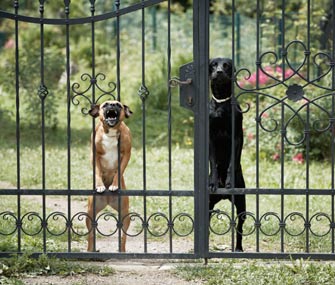How Do I Manage My Dog’s Barrier Frustration?
Published on April 15, 2013

Q. When he's off leash, my dog is friendly with other dogs. But when we're on a walk or when he's behind the fence in my yard, he lunges and barks at other dogs. I’ve been told that this behavior is caused by barrier frustration. What is that, and what can I do about it?
A. As a trainer, I work with a lot of dogs who are exhibiting barrier frustration. Over time, this behavior can escalate to more intense reactions on leash, and even off leash. For this reason, as soon as your dog shows even the first signs of barrier frustration, it’s important to get professional help, starting with your veterinarian.
Barrier frustration is different from aggression. Dogs with barrier frustration may be dog-friendly, but react when they are prevented from reaching potential playmates. Your dog may simply be excited about greeting another dog and may be acting out because he cannot reach that potential playmate. If he is punished for this behavior or is not taught an appropriate alternative response to the situation, his reaction to another dog may change from excitement and frustration to fear and aggression.
What Causes Barrier Frustration?
Certain triggers can escalate the intensity of the situation. A dog may be frustrated by a fence — even an invisible fence — because he cannot approach other canines walking by. Another trigger can be walking on leash; a dog may become agitated when he sees another dog but cannot approach. Both situations can cause a dog like yours to become agitated and appear aggressive, even if he is not.
Small cues can trigger barrier frustration. Directly approaching another dog, as often happens on walks, is more likely to cause a reaction than if the dogs were approaching each other at an arc. Meeting another reactive dog on leash may also trigger your dog’s barrier frustration, even if he would otherwise be relaxed with dogs who act nonchalant. The increased energy level and forward-leaning posture of an excited dog may trigger a bigger reaction than a dog who is calm and showing minimal interest.
Your dog also picks up on your reaction to the situation. Owners of dogs with barrier frustration often become anxious and nervous when another dog approaches, in anticipation of their dogs' reactions. Stress-related behavior, such as tightening up on or jerking the leash, is often subconscious and involuntary, but is still apparent to your dog.
When the barrier is removed, this behavior is much less likely to happen, because your dog has more freedom to approach or move away from other dogs at his own pace. He can also use body language to communicate intent to other dogs. This is why most dog parks permit dogs to be off leash; it allows dogs to communicate and approach or withdraw at their own leisure.
Barrier frustration can occur at any age, but usually begins in early adulthood. Since barrier frustration rarely goes away on its own without training, but can intensify over time, it is essential to get professional help. Start by talking to your veterinarian or asking about a referral to a qualified trainer in your area, ideally one who uses positive-reinforcement methods for training.





